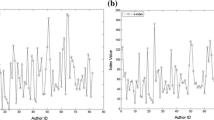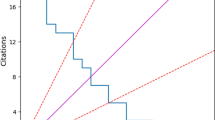Abstract
A well-designed method for evaluating scientists is vital for the scientific community. It can be used to rank scientists in various practical tasks, such as hiring, funding application and promotion. However, a large number of evaluation methods are designed based on citation counts which can merely evaluate scientists’ scientific impact but can not evaluate their innovation ability which actually is a crucial characteristic for scientists. In addition, when evaluating scientists, it has become increasingly common to only focus on their representative works rather than all their papers. Accordingly, we here propose a hybrid method by combining scientific impact with innovation under representative works framework to evaluate scientists. Our results are validated on the American Physical Society journals dataset and the prestigious laureates datasets. The results suggest that the correlation between citation and disruption is weak, which enables us to incorporate them. In addition, the analysis shows that using representative works framework to evaluate scientists is advantageous and our hybrid method can effectively identify the Nobel Prize laureates and several other prestigious prizes laureates with higher precision and better mean ranking. The evaluation performance of the hybrid method is shown to be the best compared with the mainstream methods. This study provides policy makers an effective way to evaluate scientists from more comprehensive dimensions.






Similar content being viewed by others
Data availability
The APS data can be downloaded at https://journals.aps.org/datasets. The Nobel Prize laureates data in Physics is available at https://www.nobelprize.org/prizes/physics/.
Code availability
The code for data analysis in this paper is available from the corresponding author on reasonable request.
References
Ain, Qu., Riaz, H., & Afzal, M. T. (2019). Evaluation of h-index and its citation intensity based variants in the field of mathematics. Scientometrics, 119(1), 187–211.
Ball, P., et al. (2005). Index aims for fair ranking of scientists. Nature, 436(7053), 900.
Bao, P., & Wang, J. (2018). Identifying your representative work based on credit allocation. Companion Proceedings of the Web Conference, 2018, 5–6.
Batista, P. D., Campiteli, M. G., & Kinouchi, O. (2006). Is it possible to compare researchers with different scientific interests? Scientometrics, 68(1), 179–189.
Bornmann, L., & Daniel, H. D. (2005). Does the h-index for ranking of scientists really work? Scientometrics, 65(3), 391–392.
Bornmann, L., & Tekles, A. (2019). Disruptive papers published in scientometrics. Scientometrics, 120(1), 331–336.
Bornmann, L., Devarakonda, S., Tekles, A., & Chacko, G. (2020). Are disruption index indicators convergently valid? The comparison of several indicator variants with assessments by peers. Quantitative Science Studies, 1(3), 1242–1259.
Bornmann, L., Devarakonda, S., Tekles, A., & Chacko, G. (2020). Disruptive papers published in scientometrics: Meaningful results by using an improved variant of the disruption index originally proposed by wu, wang, and evans (2019). Scientometrics, 123(2), 1149–1155.
Brin, S., & Page, L. (1998). The anatomy of a large-scale hypertextual web search engine. Computer Networks and ISDN Systems, 30(1–7), 107–117.
Chen, P., Xie, H., Maslov, S., & Redner, S. (2007). Finding scientific gems with google’s pagerank algorithm. Journal of Informetrics, 1(1), 8–15.
Cronin, B., & Meho, L. (2006). Using the h-index to rank influential information scientistss. Journal of the American Society for Information Science and Technology, 57(9), 1275–1278.
Ding, Y. (2011). Applying weighted pagerank to author citation networks. Journal of the American Society for Information Science and Technology, 62(2), 236–245.
Dorogovtsev, S. N., & Mendes, J. F. (2015). Ranking scientists. Nature Physics, 11(11), 882–883.
Egghe, L. (2006). Theory and practise of the g-index. Scientometrics, 69(1), 131–152.
Fiala, D., Šubelj, L., Žitnik, S., & Bajec, M. (2015). Do pagerank-based author rankings outperform simple citation counts? Journal of Informetrics, 9(2), 334–348.
Fortunato, S., Bergstrom, C. T., Börner, K., Evans, J. A., Helbing, D., Milojević, S., Petersen, A. M., Radicchi, F., Sinatra, R., Uzzi, B., et al. (2018). Science of science. Science, 359(6379), eaao0185.
Funk, R. J., & Owen-Smith, J. (2017). A dynamic network measure of technological change. Management Science, 63(3), 791–817.
Garfield, E., et al. (1970). Citation indexing for studying science. Nature, 227(5259), 669–671.
Hirsch, J. E. (2005). An index to quantify an individual’s scientific research output. Proceedings of the National academy of Sciences, 102(46), 16569–16572.
Hirsch, J. E. (2007). Does the h index have predictive power? Proceedings of the National Academy of Sciences, 104(49), 19193–19198.
Hirsch, J. E. (2019). h\(\alpha\): An index to quantify an individual’s scientific leadership. Scientometrics, 118(2), 673–686.
Ioannidis, J., Boyack, K. W., Small, H., Sorensen, A. A., & Klavans, R. (2014). Bibliometrics: Is your most cited work your best? Nature, 514(7524), 561–562.
Jin, B., Liang, L., Rousseau, R., & Egghe, L. (2007). The r-and ar-indices: Complementing the h-index. Chinese Science Bulletin, 52(6), 855–863.
Kaur, J., Radicchi, F., & Menczer, F. (2013). Universality of scholarly impact metrics. Journal of Informetrics, 7(4), 924–932.
Kosmulski, M., et al. (2006). A new hirsch-type index saves time and works equally well as the original h-index. ISSI Newsletter, 2(3), 4–6.
Lehmann, S., Jackson, A. D., & Lautrup, B. E. (2006). Measures for measures. Nature, 444(7122), 1003–1004.
Li, S., Shen, H., Bao, P., & Cheng, X. (2021). \(h_u\) hu-index: A unified index to quantify individuals across disciplines. Scientometrics, 126(4), 3209–3226.
Liu, X., Bollen, J., Nelson, M. L., & Van de Sompel, H. (2005). Co-authorship networks in the digital library research community. Information Processing & Management, 41(6), 1462–1480.
Lü, L., Medo, M., Yeung, C. H., Zhang, Y. C., Zhang, Z. K., & Zhou, T. (2012). Recommender systems. Physics Reports, 519(1), 1–49.
Ma, N., Guan, J., & Zhao, Y. (2008). Bringing pagerank to the citation analysis. Information Processing & Management, 44(2), 800–810.
Mariani, M. S., Medo, M., & Zhang, Y. C. (2016). Identification of milestone papers through time-balanced network centrality. Journal of Informetrics, 10(4), 1207–1223.
Niu, Q., Zhou, J., Zeng, A., Fan, Y., & Di, Z. (2016). Which publication is your representative work? Journal of Informetrics, 10(3), 842–853.
Nykl, M., Ježek, K., Fiala, D., & Dostal, M. (2014). Pagerank variants in the evaluation of citation networks. Journal of Informetrics, 8(3), 683–692.
Oppenheim, C. (2007). Using the h-index to rank influential British researchers in information science and librarianship. Journal of the American Society for Information Science and Technology, 58(2), 297–301.
Radicchi, F., Fortunato, S., & Castellano, C. (2008). Universality of citation distributions: Toward an objective measure of scientific impact. Proceedings of the National Academy of Sciences, 105(45), 17268–17272.
Radicchi, F., Fortunato, S., Markines, B., & Vespignani, A. (2009). Diffusion of scientific credits and the ranking of scientists. Physical Review E, 80(5), 056103.
Redner, S. (1998). How popular is your paper? An empirical study of the citation distribution. The European Physical Journal B-Condensed Matter and Complex Systems, 4(2), 131–134.
Ruan, X., Lyu, D., Gong, K., Cheng, Y., & Li, J. (2021). Rethinking the disruption index as a measure of scientific and technological advances. Technological Forecasting and Social Change, 172, 121071.
Shen, H. W., & Barabási, A. L. (2014). Collective credit allocation in science. Proceedings of the National Academy of Sciences, 111(34), 12325–12330.
Shibayama, S., & Wang, J. (2020). Measuring originality in science. Scientometrics, 122(1), 409–427.
Sinatra, R., Wang, D., Deville, P., Song, C., & Barabasi, A. L. (2016). Quantifying the evolution of individual scientific impact. Science, 354(6312), aaf5239.
Wang, D., Song, C., & Barabási, A. L. (2013). Quantifying long-term scientific impact. Science, 342(6154), 127–132.
Wang, H., Shen, H. W., & Cheng, X. Q. (2016). Scientific credit diffusion: Researcher level or paper level? Scientometrics, 109(2), 827–837.
Wang, J. P., Guo, Q., Zhou, L., & Liu, J. G. (2019). Dynamic credit allocation for researchers. Physica A: Statistical Mechanics and Its Applications, 520, 208–216.
Wu, L., Wang, D., & Evans, J. A. (2019). Large teams develop and small teams disrupt science and technology. Nature, 566(7744), 378–382.
Xu, S., Mariani, M. S., Lü, L., & Medo, M. (2020). Unbiased evaluation of ranking metrics reveals consistent performance in science and technology citation data. Journal of Informetrics, 14(1), 101005.
Yan, E., & Ding, Y. (2011). Discovering author impact: A pagerank perspective. Information Processing & Management, 47(1), 125–134.
Zeng, A., Shen, Z., Zhou, J., Wu, J., Fan, Y., Wang, Y., & Stanley, H. E. (2017). The science of science: From the perspective of complex systems. Physics Reports, 714, 1–73.
Zeng, A., Fan, Y., Di, Z., Wang, Y., & Havlin, S. (2021). Fresh teams are associated with original and multidisciplinary research. Nature Human Behaviour, 5(10), 1314–1322.
Zhang, F., & Wu, S. (2021). Measuring academic entities impact by content-based citation analysis in a heterogeneous academic network. Scientometrics, 126(8), 7197–7222.
Zhou, J., Zeng, A., Fan, Y., & Di, Z. (2018). Identifying important scholars via directed scientific collaboration networks. Scientometrics, 114(3), 1327–1343.
Zhou, J., Zeng, A., Fan, Y., & Di, Z. (2018). The representative works of scientists. Scientometrics, 117(3), 1721–1732.
Zhu, X., Turney, P., Lemire, D., & Vellino, A. (2015). Measuring academic influence: Not all citations are equal. Journal of the Association for Information Science and Technology, 66(2), 408–427.
Acknowledgements
This work was supported by the National Natural Science Foundation of China (Grant No. 72274020) and the Swiss National Science Foundation (Grant No. 182498). Ruijie Wang acknowledges the support from the China Scholarship Council (CSC).
Author information
Authors and Affiliations
Corresponding author
Ethics declarations
Conflict of interest
The authors have no conflict of interest to declare.
Supplementary Information
Below is the link to the electronic supplementary material.
Rights and permissions
Springer Nature or its licensor (e.g. a society or other partner) holds exclusive rights to this article under a publishing agreement with the author(s) or other rightsholder(s); author self-archiving of the accepted manuscript version of this article is solely governed by the terms of such publishing agreement and applicable law.
About this article
Cite this article
Wang, R., Zhou, Y. & Zeng, A. Evaluating scientists by citation and disruption of their representative works. Scientometrics 128, 1689–1710 (2023). https://doi.org/10.1007/s11192-023-04631-7
Received:
Accepted:
Published:
Issue Date:
DOI: https://doi.org/10.1007/s11192-023-04631-7




